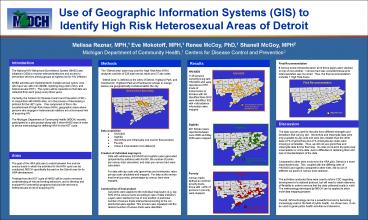The - PowerPoint PPT Presentation
1 / 1
Title:
The
Description:
Use of Geographic Information Systems (GIS) to Identify High Risk Heterosexual Areas of Detroit Melissa Reznar, MPH,1 Eve Mokotoff, MPH,1 Renee McCoy, PhD,1 Shanell ... – PowerPoint PPT presentation
Number of Views:24
Avg rating:3.0/5.0
Title: The
1
Use of Geographic Information Systems (GIS) to
Identify High Risk Heterosexual Areas of Detroit
Melissa Reznar, MPH,1 Eve Mokotoff, MPH,1 Renee
McCoy, PhD,1 Shanell McGoy, MPH2 Michigan
Department of Community Health,1 Centers for
Disease Control and Prevention2
Introduction
Final Recommendation 8 census tracts intersected
when all of these layers were stacked on top of
one another. 1 census tract was excluded because
its total population was too small. Thus, the
final recommendation includes 7 High Risk Areas.
Methods
Results
The National HIV Behavioral Surveillance System
(NHBS) was initiated in 2004 to monitor selected
behaviors and access to prevention services among
groups at highest risk for HIV infection. NHBS
activities are implemented in multiple annual
cycles men who have sex with men (MSM),
injecting drug users (IDU), and heterosexuals
(HET). The cycles will be repeated so that data
are collected from each group every three
years. Currently, the Centers for Disease
Control and Prevention (CDC), in conjunction with
NHBS sites, is in the process of developing a
protocol for the HET cycle. One component of
this is the ascertainment of High Risk Areas
(HRA), geographic areas where persons who engage
in heterosexual relations are at increased risk
of acquiring HIV. The Michigan Department of
Community Health (MDCH) recently participated in
a pilot project along with 5 other NHBS sites in
order to devise methodology for defining HRA for
the HET cycle.
The Detroit area base map used for High Risk
Area (HRA) analyses consists of 329 total census
tracts and 27 zip codes. Detroit area is
defined as the cities of Detroit, Highland Park,
and Hamtramck. Highland Park and Hamtramck
(shown in orange below) are geographically
contained within the city.
HIV/AIDS 1146 persons currently living with
HIV/AIDS who were reported as HRH mode of
transmission or females with No Identified Risk
(NIR) were identified. 502 with valid address
information were mapped.
HIV/AIDS
Final Recommendation
Detroit Area Base Map
Top Quartile of Census Tracts by Rate of HIV/AIDS
(n57)
High Risk Area
Discussion
Syphilis 481 female cases reported between June
2000 and May 2005 were mapped.
Syphilis
- Data acquisition
- HIV/AIDS
- Syphilis
- Gonorrhea and Chlamydia (not used in final
product) - Poverty
- Crime incarceration (not obtained)
The data sources used for the pilot have
different strengths and limitations that vary by
site. Gonorrhea and chlamydia data were only
available by zip code and were less reliable than
the other data (47 of gonorrhea and 41
chlamydia zip codes were missing or unreliable).
Thus, we did not use gonorrhea and chlamydia data
for the final map. No sites involved in the
pilot used incarceration or crime data, due to
difficulties in obtaining them and lack of
standardization of the data. Compared to other
sites involved in the HRA pilot, Detroit is a
more impoverished city. This, coupled with the
differing rates of HIV/AIDS and syphilis compared
to other sites, led to use of different cut
points in census tract selection. The activities
conducted here were used to inform CDC regarding
development of a national protocol, but will need
to retain elements of flexibility in order to
ensure that the data collected locally is valid.
The methodology developed by MDCH can be applied
to other multi-data mapping projects. Overall,
GIS technology can be a powerful tool and is
becoming increasingly used in the field of public
health. As shown here, It can be used to guide
public health activities and decisions.
Creation of individual map layers Data with
addresses (HIV/AIDS and syphilis) were geocoded
(pinpointed by address) with ArcGIS, the number
of points per census tract calculated, and rates
per census tract were calculated. For data with
zip code only (gonorrhea and chlamydia), rates
per zip code calculated and mapped. For data at
the census tract level (poverty), percentages by
census tract were mapped.
Aims
Top Quartile of Census Tracts by Rate of Syphilis
(n54)
The goal of the HRA pilot was to select between
five and ten census tracts in which the
activities for the HRH cycle can be conducted.
MDCH specifically focused on the Detroit area for
its HRA development. Findings from the HET cycle
of NHBS will be used to enhance understanding of
risk and testing behaviors, and to develop and
evaluate HIV prevention programs that provide
services to heterosexuals at risk of acquiring
HIV.
Poverty Census tracts defined as extreme poverty
tracts, those with gt40 of persons in poverty,
were mapped.
Poverty
Construction of final product Cut points were
applied to the individual map layers (e.g. top
50 of the census tracts according to rate of
data indicator). Layers were stacked on top of
one another. A particular number of census tracts
intersected according to the cut points that were
applied. This process was repeated until the
desired number of census tracts were identified.
Census Tracts Defined as Extreme Poverty (n49)

